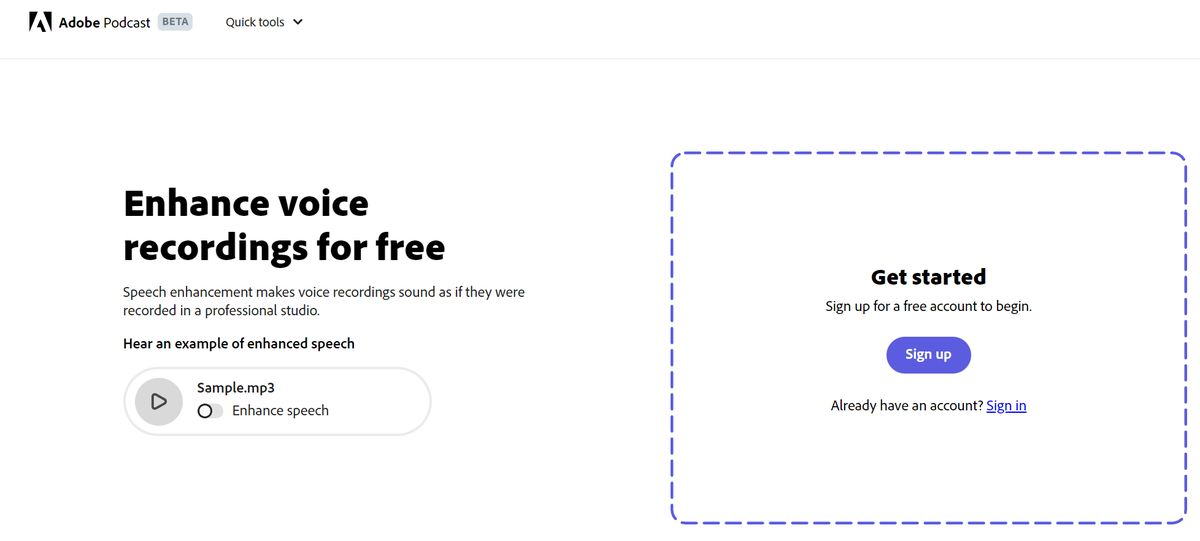Adobe's browser-based podcast tool, formerly known as Project Shasta, is set to make it easier for creators to make quality audio productions without needing to learn complex audio editing software. The cloud-based tool, which is still in beta, is aimed primarily at podcast production but could also appeal to anyone working with narrative audio. Unlike traditional audio editors, there's no audio timeline and no mixer view with channels, and the user interface looks more like a text document editor than an audio editing program.
According to Mark Webster, Director of Product at Adobe, the goal of the podcast tool was to create a broader voice strategy for Adobe that would make it easier for users to create spoken audio. The result is a storytelling tool that allows creators to edit their podcast as they would a text document. Anything recorded through Adobe Podcast will be automatically transcribed, and users can simply edit the text to make changes, which are then reflected in the audio. The tool even includes extra features for creating artwork.
Sam Anderson, Adobe Podcast's Lead Designer, explains that the tool isn't designed to be another audio tool but a storytelling tool. Anderson argues that traditional audio tools' features, such as looking at audio waveforms and decibel levels, aren't relevant when creating a podcast. Instead, it's better to work on the text first, as podcasts are all about what's being said. Using this approach, creators can see what's being said without playing it back repeatedly to find the right spot.
While Adobe Podcast offers many benefits, there are some trade-offs. Creators will need to learn to relinquish some control over their editing. Unlike in an audio editor, where users can choose precisely where to trim an audio segment, in Adobe Podcast, users can only highlight text, and the finer details of the edit are taken care of by the backend. This can limit users' creative control over their editing, and they may still need to make minor edits after exporting from Podcast.
One significant advantage of online tools like Adobe Podcast is how easy it is to invite guests. In the past, creators had to guide guests through setting up their audio and then transfer large audio files around after recording. With Podcast, guests can accept an invite, like they would for a Zoom meeting, and then converse in real-time while the local audio is uploaded in the background. The result is a frictionless way to get local audio that's transcribed and ready to edit in one go.
Adobe Podcast's secret weapon could be its singular focus on audio, unlike rival products, which also include video editing, presentation, or livestreaming tools that may not be necessary. Additionally, Adobe Podcast includes proprietary tools such as "Enhance Speech," which can transform poor-quality audio recorded in an unideal setting into a more professional-sounding recording with just one click.

Adobe's browser-based podcast tool offers an innovative approach to audio editing that could make it easier for creators to produce quality podcasts. While it may require some trade-offs in terms of control, the tool's ease of use and features like "Enhance Speech" could make it a go-to option for creators looking to get started in podcasting.
Adobe Podcast also offers a variety of free music for intros, outros, and transitions, though editing them to work with speech can be a bit challenging due to the service still being in beta. However, users can get creative by splicing music tracks in two and setting one to "background" to achieve the desired effect. Adobe's Director of Product, Mark Webster, explained that they're still figuring out the best way to add tools that will guide novices without alienating more advanced users.
While some may wonder if Adobe plans to add an AI voice tool that allows users to add words by typing them in, it's unlikely to happen anytime soon. According to Webster, to make an effective voice model, it needs to be trained on enough material to only make sense for one's voice. Additionally, AI voices can be clunky, so Adobe decided to make it easy for users to re-record the lines they wanted, rather than patch over misspeaks.
Adobe Podcast is available to everyone
One of the best features of Adobe Podcast is the lack of friction between ideas and getting something down on the page. Anyone familiar with Google Docs can create a podcast with Adobe Podcast. The bundled music and mic-enhancement tools also increase the chances of creating quality content. The service will remain in beta for the foreseeable future, with a free tier always available for users. Those who only want to use the speech-enhancing feature can access it without signing up for the beta.
Thank you for being a Ghacks reader. The post Edit audio like a pro with Adobe's new podcast tool appeared first on gHacks Technology News.

0 Commentaires